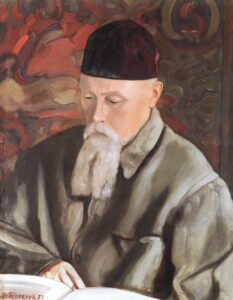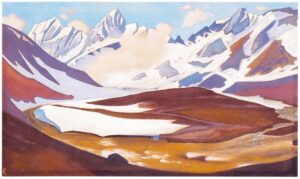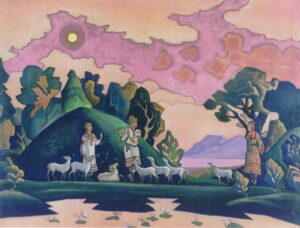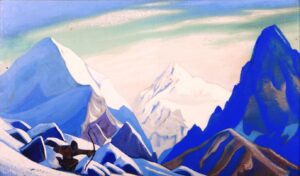The National Gallery of Modern Art, New Delhi, has released a landmark monograph, Indian Odyssey: Art, Spirit, and Legacy of Nicholas Roerich, authored by art historians Dr. Vladimir Zaitsev and Dr. Natalia R. Kravchenko. The volume offers a deep, richly researched perspective on Nicholas Roerich (1874–1947), the celebrated Russian painter, philosopher, and cultural visionary who made India his spiritual and creative home.

S. Roerich. Portrait of Nicholas Roerich. Allahabad Museum
Roerich holds a unique place in India’s cultural narrative. He is the only foreign-born artist to be included among the Navratna — the nine masters of Indian national art — alongside Nandalal Bose, Jamini Roy, Amrita Sher-Gil, Sailoz Mookherjea, the Tagores, and others. His artistic pilgrimage to the Himalayas began in 1923, leading to an extraordinary outpouring of works that redefined mountain painting. His celebrated series — Banners of the East, Strongholds of Tibet, Himalayas, Kuluta — earned him the title “Master of the Mountains.”
To Roerich, the Himalayas were not merely landscapes but sacred presences — the Devatma, the “God-souled” mountains. His canvases shimmer with metaphysical hues, revealing mountains as living symbols of eternity, memory, and awakening. In his hands, landscape became spiritual experience.
India today holds one of the largest and most important collections of Roerich’s works, housed across museums, cultural academies, and private collections. Early acquisitions by Bharat Kala Bhawan, Allahabad Museum, Trivandrum Art Gallery, and Baroda Museum played a quiet but foundational role in India’s modern artistic renaissance.

N.Roerich, Source of Indus. Sri Jayachamarajendra Art Gallery, Musuru Museum
This monograph is the first to comprehensively document Roerich’s Indian legacy — tracing how his works were acquired, catalogued, misplaced, restored, and rediscovered over nearly a century. The book presents rare archival letters, photographs, sketches, and artworks — many reproduced for the very first time, including pieces long believed lost.
In Conversation with Dr. Vladimir Zaitsev, Co-author and Publisher of Indian Odyssey
The Luxury Chronicle: What drew you and Dr. Natalia Kravchenko to create this extensive monograph?
Dr. Vladimir Zaitsev: Roerich’s world is endlessly compelling: from ancient Russian legends to the peaks of the Himalayas and the deserts of Central Asia. His art was inseparable from his mission — to elevate human consciousness and protect the world’s cultural heritage. Though Roerich’s works are widely present in India, very few detailed studies exist here. India was his second home, and we felt it was essential to tell that story — to show how a Russian artist became beloved as a national figure, even an “Apostle of Peace.”

N.Roerich.The Holy Shepherd.(Krishna-Lel). Allahabad Museum
TLC: What proved most challenging during your research?
Dr. Zaitsev: Reconstructing events from nearly a century ago. Many letters, journals, exhibition notes, and photographs survive only in single fragile copies — sometimes scattered across India, Moscow, or New York. Piecing these together was like reconstructing a cultural map.

N.Roerich. Command of Rigden Djapo. Government Museum and Art Gallery, Chandigarh
TLC: The book recounts the rediscovery of rare and lost works. Could you share one that stands out?
Dr. Zaitsev: In 2010, two Roerich works disappeared from a public collection in New Delhi and surfaced in a London auction. It took six years of legal work to return them to India.
Another deeply moving case was the restoration of his painting Santana, found deteriorating in a Kolkata archive. Thanks to INTACH experts, it was restored and exhibited again in 2025 — a homecoming of sorts.
And then there is The Ruler — gifted to Rabindranath Tagore in 1920, thought lost for decades, now safely housed at Visva-Bharati.

N.Roerich. The Hunt. Indian Agriculture Research Institute, Pusa, New Delhi
TLC: Was authentication difficult across museums and private collections?
Dr. Zaitsev: Roerich wrote extensively — in correspondence, notebooks, essays — and museums maintain detailed registers. Later collections were also shaped by his son Svetoslav Roerich, in Bangalore and Kulu. Private works still appear at auctions, so the research continues.
A Legacy of Light
Indian Odyssey is more than an art book. It is a record of a cultural bridge between India and Russia — between earth and sky — shaped by a man who believed that beauty could build peace. For museum curators, historians, art collectors, and anyone who has ever looked at the Himalayas and felt something stir — this book offers a rare and resonant journey.
